The New Zealand Book Awards for Children and Young Adults are a core part of the Aotearoa literary calendar, for young people and adults alike. They acknowledge excellence in writing, illustration and publishing, and provide a vital platform to celebrate the best and most vibrant things going on in the kids’ lit scene.
There are six main categories, with prize money of $7,500 to each winner – plus a Best First Book prize, awarded at the judges’ discretion, which has a value of $2,000. The big moment of the night is the presentation of the Margaret Mahy Book of the Year Award, which will be selected from the category winners.
Since Jane Arthur, one of The Sapling’s founding editors, is on the judging panel this year, all award-related coverage and hot takes are being provided by our other editors and contributors, with no cross-pollination.
What follows is a brief selection of stats on what the make-up of the finalist lists look like – along with commentary from Sarah Forster and Briar Lawry on what we reckon our picks are for each category. We can’t let Jane have all the fun!
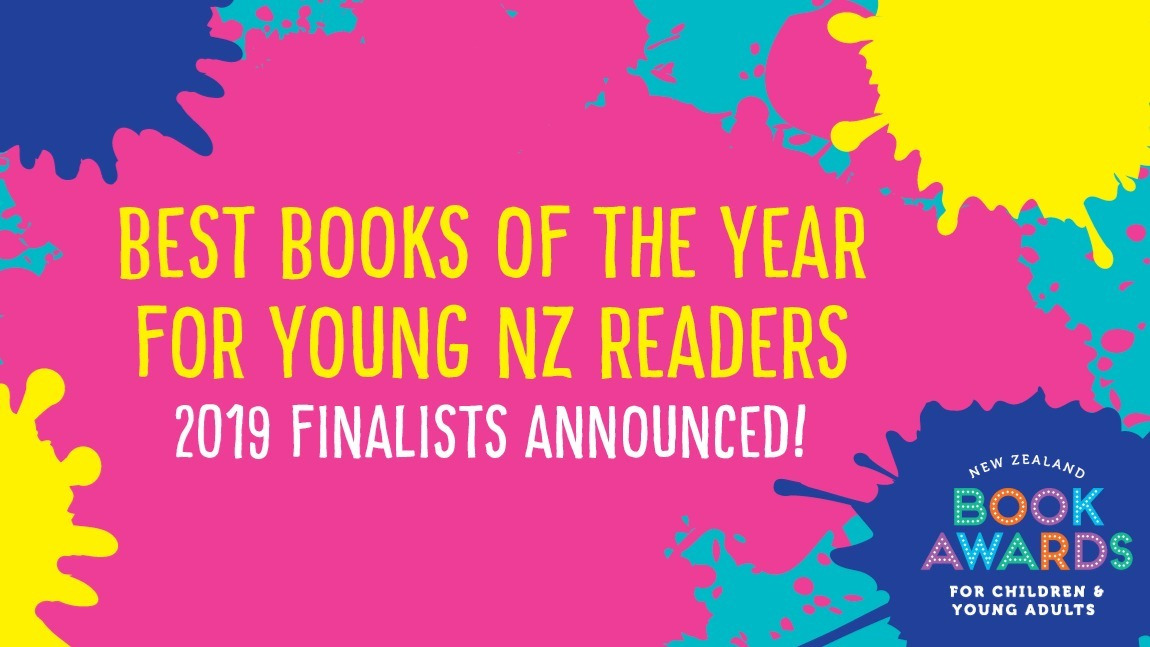
LOOKING AT THE NUMBERS…
There are 15 publishers represented in this year’s finalists, 11 of which are local presses and four of which are part of larger international organisations. So who comes out tops?
Huia Publishing and Penguin Random House NZ both boast finalists in four categories – Huia with one per relevant category and Penguin Random House with seven finalists across the four categories.
Penguin Random House is once again on top when it comes to sheer numbers, with seven different titles. Scholastic NZ comes in second, with four or five books represented, depending on which way you cut things, with English and te reo Māori versions of one title featuring.
Scholastic NZ, Penguin Random House NZ, Potton & Burton and Gecko Press all have categories where they are competing against themselves – Scholastic has two finalists in the Picture Book and Best First Book categories, Penguin Random House has two finalists in the Picture Book, Young Adult Fiction and Illustration (the Russell Clark Award) categories, while Potton & Burton and Gecko Press have double-ups in Non-Fiction (the Elsie Locke Award) and Best Illustration respectively.
That’s things from a publisher perspective – how about some other breakdowns?
We can say with certainty that a woman will take home the Best Picture Book and Best YA Book prizes, with all five finalist authors in each category being female. There are five finalists in six of the categories, and three finalists in Te Kura Pounamu – so 33 different finalist slots. 24 of 33 are women, with four of the nine male finalists coming under the Best Illustration category. Perhaps that’s a call to arms for male writers with a yearning to write a children’s book…
There are also some very familiar faces, suggesting some of the Kiwi literary community are very, very busy folks! Last year’s Margaret Mahy Book of the Year winner, Gavin Bishop, is a finalist again, this time for his illustration in Cook’s Cook: The Cook Who Cooked for Captain Cook. Bren MacDibble took both the Junior Fiction and YA categories last year (the latter under her pen name Cally Black) – and she’s back as a finalist in Junior Fiction with new release The Dog Runner.
Beyond last year, there are also some highly important recurring names. Mandy Hager, Vasanti Unka and David Elliot have all previously won the Margaret Mahy Book of the Year award, while both Donovan Bixley and the dynamic duo of Sacha Cotter and Josh Morgan have taken out category wins before. Stacy Gregg and Rachael Craw have received Children’s Choice awards in years past – no longer awarded, but worthy of highlighting – and similarly, Whiti Hereaka, Barbara Else and Ant Sang have received Honour awards.
That is a stacked line-up! And just to make sure things are future-proofed, three of the five finalists for Best First Book are also finalists in their respective categories, suggesting some extra strong new voices on the scene this year.
THE PICTURE BOOK AWARD FINALISTS
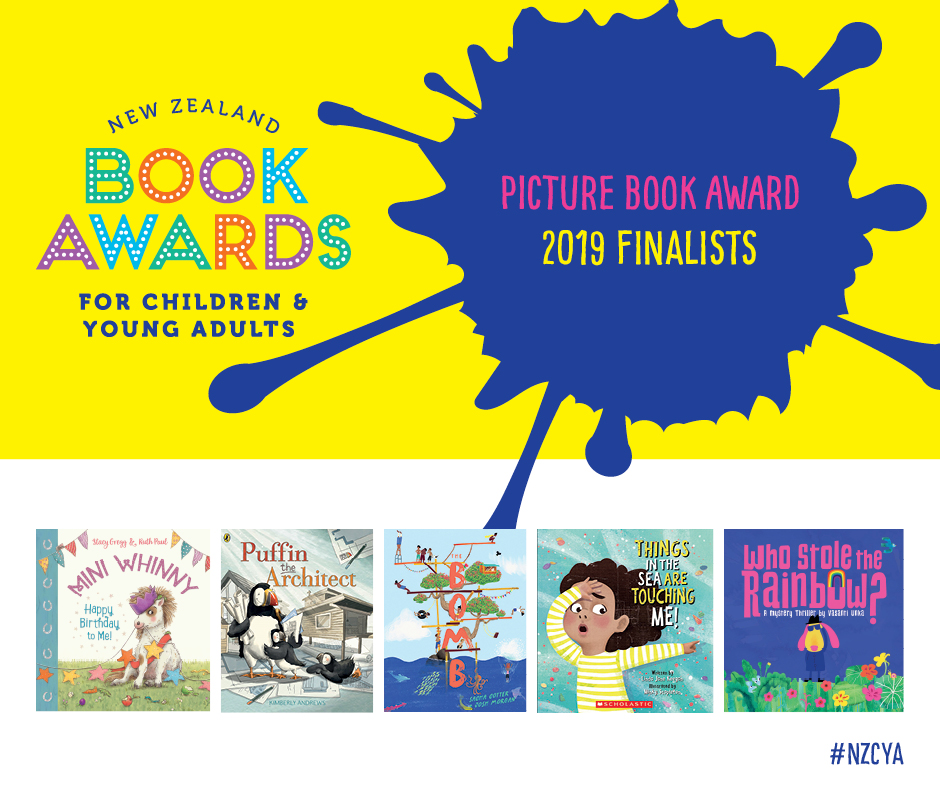
Mini Whinny: Happy Birthday to Me, by Stacy Gregg and Ruth Paul (Scholastic NZ)
Equestrian fiction queen Stacy Gregg keeps things pony-focused but turns her hand to picture books in this very sweet collaboration with Ruth Paul.
Puffin the Architect, by Kimberly Andrews (Penguin Random House)
Any adult who is respected in their field by their peers who have kids who really couldn’t care less will really feel for Puffin, while kids and grown-ups alike will love the A+ rhyme.
The Bomb, by Sacha Cotter, and Josh Morgan (Huia Publishers)
The most quintessentially Kiwi summer book ever, perhaps? A super colourful, sumptuously illustrated tale of perseverance and paving your own way.
Things in the Sea are Touching Me, by Linda Jane Keegan and Minky Stapleton (Scholastic NZ)
A message of bravery and encouraging environmental inquisitiveness, all with a cool and non-gendered kid who also happens to have same sex parents. Very of our times.
Who Stole the Rainbow? by Vasanti Unka (Penguin Random House)
This punch of purple and pink is a glorious combination of mystery and undercover learning opportunities – from the super talented woman who previous took top honours with The Boring Book.
Sarah: This is hard! I’m going to pitch for Puffin the Architect, by Kimberley Andrews because when I read it last year I was so blown away by its artful rhyme matched with incredible, multi-layered pictures, I just had to have it for myself. But it would not at all surprise me if The Bomb took this out – Sacha and Josh just keep getting better (and I’m looking forward to meeting their pēpē at the awards!) Can I have a bet each way, or is that greedy?
Briar: It’s a loaded field, but if Sarah gets to pick two, so do I! I second The Bomb – it’s beautifully told and illustrated and the boy’s flamboyant ensemble when he finally (SPOILERS) does his bomb is phenomenal. But I’m also staunchly pro Things in the Sea are Touching Me, not only for what it does for representation of ‘non-traditional’ families and kids with nervy demeanours, but also because it manages to do all that with a lovely lilting rhyme scheme that packs in some amazing quirks.
THE WRIGHT FAMILY FOUNDATION ESTHER GLEN AWARD FOR JUNIOR FICTION FINALISTS
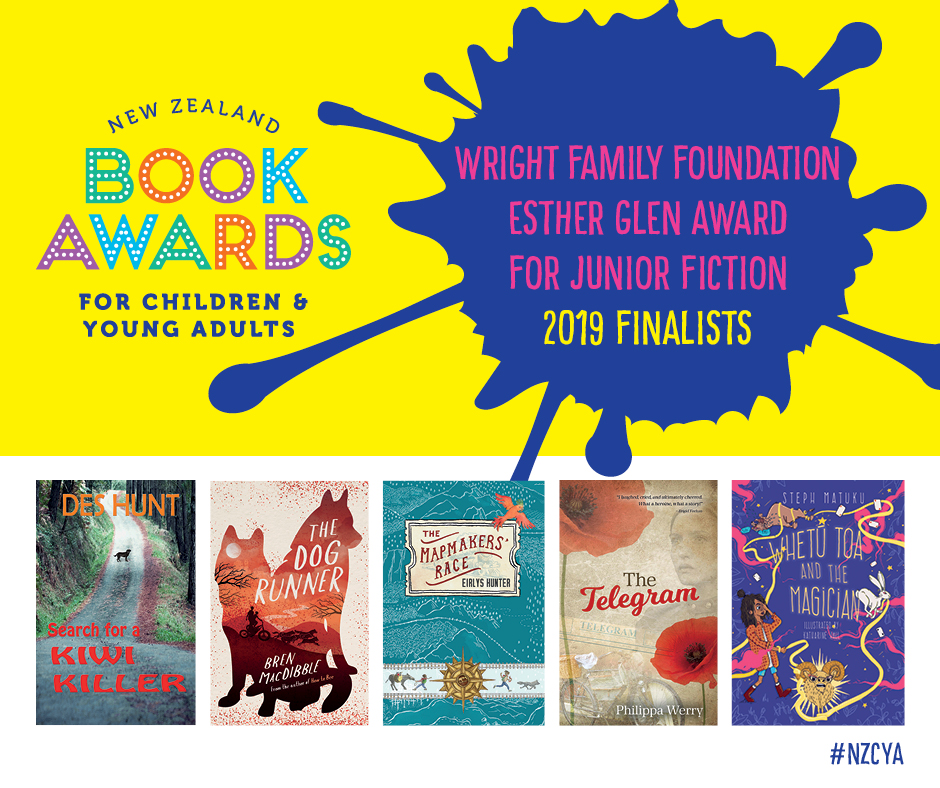
Search for a Kiwi Killer, by Des Hunt (Tōrea Press)
Des Hunt always dependably provides Kiwi readers with bush adventures and remote locations, and Search for a Kiwi Killer continues that with a real environmental conscience.
The Dog Runner, by Bren MacDibble (Allen & Unwin)
Another environmentally aware junior fiction offering from last year’s category winner Bren MacDibble. Long distance travel in an apocalyptic setting means dog-sledding across the barren land.
The Mapmakers’ Race, by Eirlys Hunter, illustrated by Kirsten Slade (Gecko Press)
Shades of Enid Blyton-esque adventure for today’s kids – four siblings uphold the family honour and compete in a mapmaking race when their mother is unable to do so.
The Telegram, by Philippa Werry (Pipi Press)
This is an at-times heart-breaking story of life back home in small town Aotearoa during the First World War, from the perspective of a young woman being called to duty.
Whetū Toa and the Magician, by Steph Matuku, illustrated by Katharine Hall (Huia Publishers)
Skewing a little younger than the other finalists, this is a fabulous fable of Whetū and her mum working at a magician’s farm… and the strange things that go on as a result.
Sarah: Always bet on Bren, that’s my motto. After correctly guessing Bren as Junior Fiction winner last year, the only category selection I missed guessing was the YA that was also by her, under her pseudonym! The Dog Runner is another fabulous novel from Bren MacDibble, my new favourite NZ-Aussie. It tells diverse stories, and focuses on a climate disaster and its effect on Australia in particular, while telling a mile-a-minute adventure story.
Briar: Obviously the awards are picked by adults rather than kids, but from the frontlines of children’s bookselling, grown-ups and kids alike have been all over The Mapmaker’s Race, and for good reason. It’s a rollicking adventure, and in true Gecko Press style it’s a beautifully presented publication, from the gatefold flaps to the little illustrations. But then again, I wouldn’t bet against Bren, of course!
THE YOUNG ADULT FICTION AWARD finalists
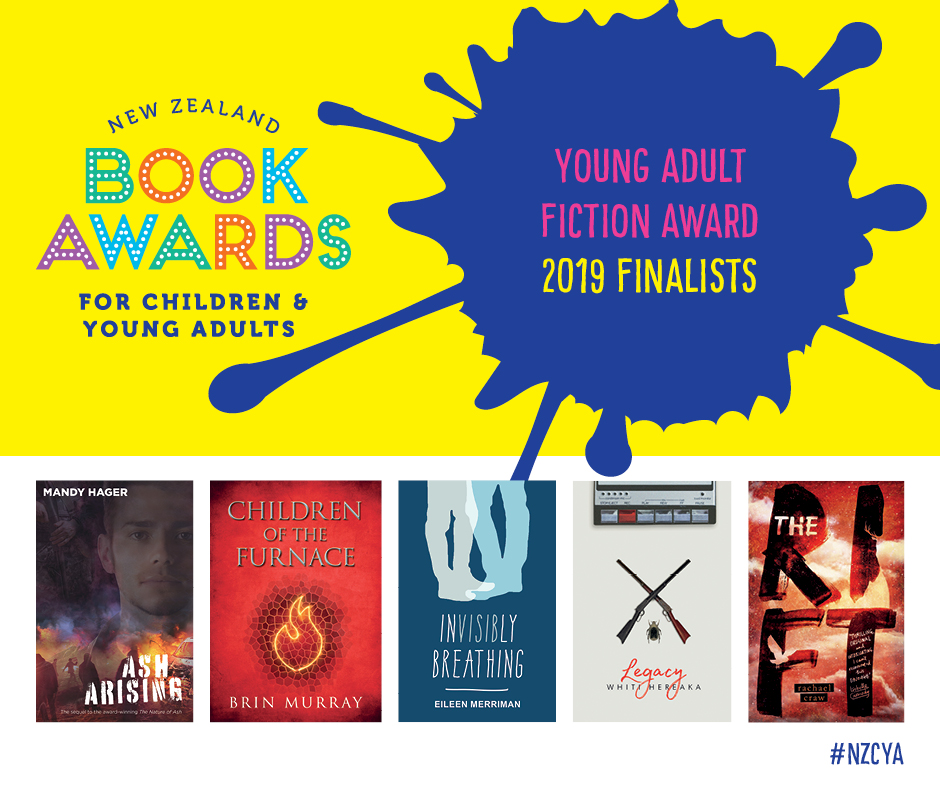
Ash Arising, by Mandy Hager (Penguin Random House)
Relatively unusually in such awards, this is a sequel. Following on from the bleak but brilliant The Nature of Ash, this is a cracker of a read for any teen keen on intrigue and thrillers.
Children of the Furnace, by Brin Murray (The CopyPress)
An impressive debut from Brin Murray, this is a dark and twisty fantasy tale that follows excellent protagonist Wil and does it all with a unique take on language via ‘dialect’.
Invisibly Breathing, by Eileen Merriman (Penguin Random House)
A beautiful and tear-jerking love story of two boys in Lower Hutt. Felix and Bailey are both fully realised unique characters with complex backstories and secrets.
Legacy, by Whiti Hereaka (Huia Publishers)
Scifi meets war-time historical fiction in this richly imagined novel, with the twisty nature of time travel and the development of empathy between generational experiences playing key roles.
The Rift, by Rachael Craw (Walker Books Australia)
It’s fantasy, but not high fantasy – our world, but a little different. From the perspectives of Meg and Cal, we get to know Black Water Island and its inhabitants, in a high-pressure setting.
Sarah: Ooh this is a tricky one, as three of these books are very good contenders for the prize. I really loved Legacy and it’s time-slipping war adventure, it was a really unique take on whānau history and Māori involvement in WWI. I was also carried away by Ash Arising, which sees several generations work together to battle a corrupt government right here in Wellington. But I think – I think… Eileen Merriman might win this year for Invisibly Breathing. I loved the characters, the plot was realistic but exciting and it left you with a lot to think about.
Briar: I’m team Invisibly Breathing, I think. I’ve loved all of the books that Eileen has put out in remarkably quick succession, but something about this one has really stuck with me. It was a come-with-me-in-bag-for-reading-at-any-spare-moment book, which is a high honour when I have so many on the go… But I am also a big fan of Rachael Craw, and The Rift has been a big hit both with me as an individual reader and with teens (and parents of them) who I’ve talked to. Eileen or Rachael for the win.
THE ELSIE LOCKE AWARD FOR NON-FICTION FINALISTS
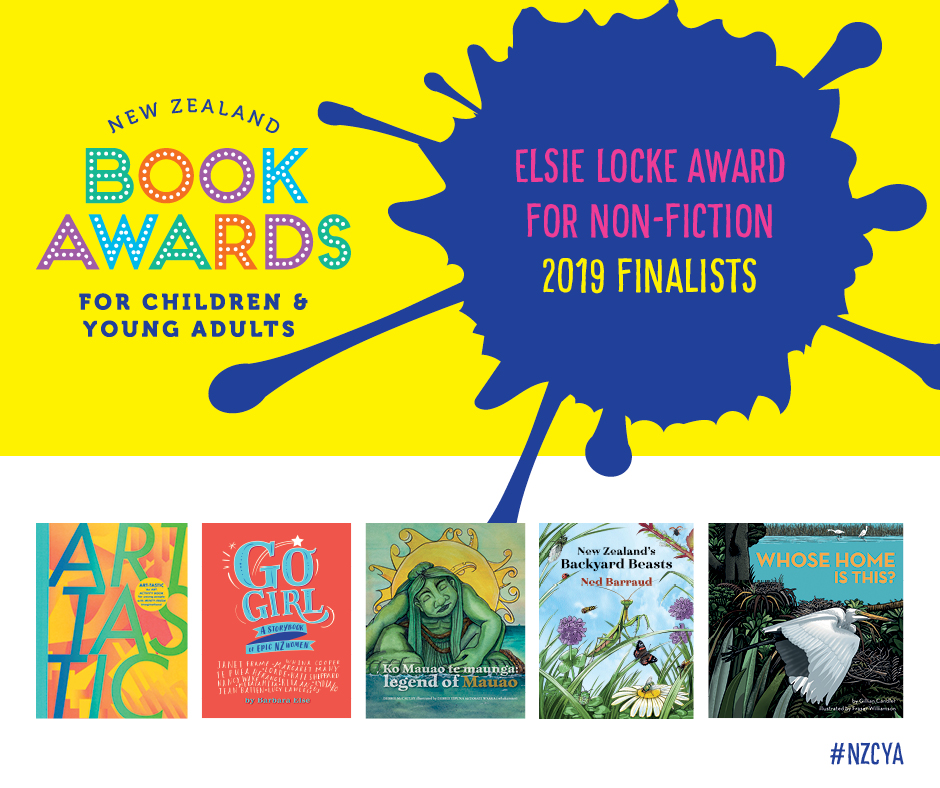
Art-tastic, by Sarah Pepperle (Christchurch Art Gallery Te Puna o Waiwhetū)
A brilliant fact-filled activity book that’s going to be an absolute hit with anyone who has the pleasure of picking it up! That cover really grabs your attention, too, and it that doesn’t sell it, the flowchart will!
Go Girl: A Storybook of Epic NZ Women, by Barbara Else (Penguin Random House)
The NZ answer to Good Night Stories for Rebel Girls, Go Girl brings together an amazing assortment of Kiwi girls and women – and special mention to the nine amazing Kiwi female artists who bring the words to life with their pictures.
Ko Mauao te Maunga: Legend of Mauao, by Debbie McCauley and Debbie Tipuna, translated by Tamati Waaka (Mauao Publishing)
A bilingual (English and te reo Māori) book sharing the story of Mauao, a major local tipuna in pūrākau from the Tauranga Moana area. Always great to see local stories getting a wider audience.
New Zealand’s Backyard Beasts, by Ned Barraud (Potton & Burton)
First of two P&B offerings, this is an awesome exploration of all the different bugs and greeblies you can encounter in the average Kiwi backyard.
Whose Home is This?, by Gillian Candler and Fraser Williamson (Potton & Burton)
And the second P&B title, Whose Home is This? is the latest in a series of Kiwi critter focused non-fiction picture books. Perfect for younger readers learning about different creatures and habitats.
Sarah: Have you seen Art-tastic? You will fall in love with it instantly. It’s definitely a winner.
Briar: Very pro Go Girl, and the broad variety of different Kiwi women it covers. Kate Sheppard, Whina Cooper, Georgina Beyer, Lorde, Lydia Ko… all kinds of incredible folks. And I’m obsessed with the artwork – PRH very sensibly released some beautiful postcards as marketing collateral and they must be adorning a whole lot of walls!
THE Russell Clark Award for Illustration FINALISTS
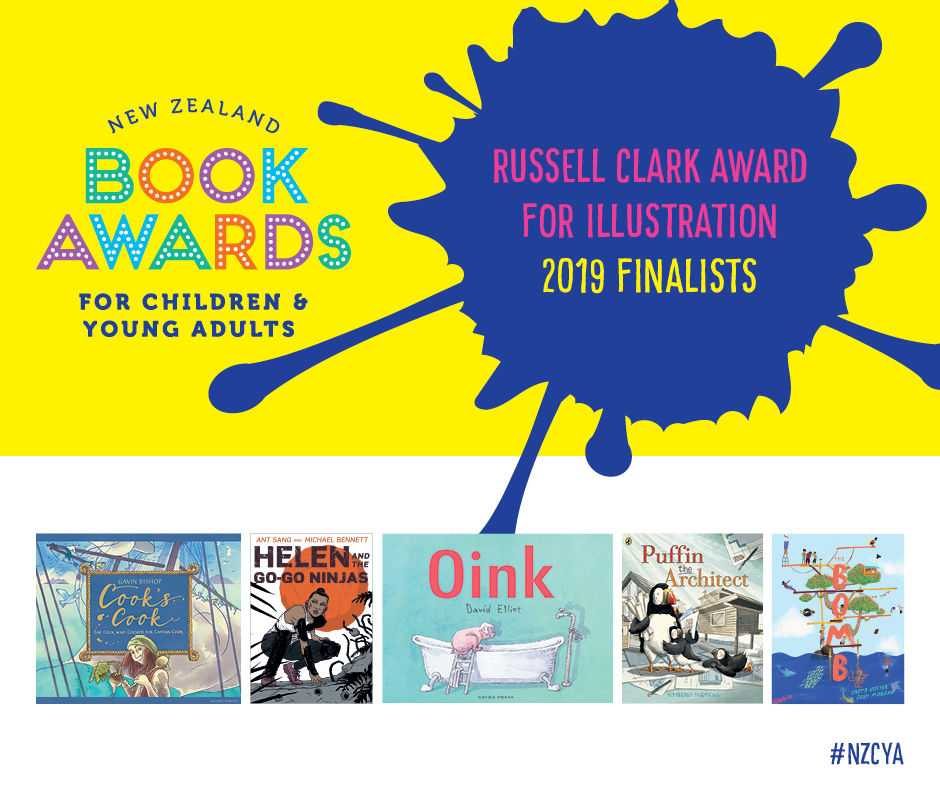
Cook’s Cook: The Cook who Cooked for Captain Cook, by Gavin Bishop (Gecko Press)
Gavin Bishop masterfully integrates his words into his illustrations, and readers are all the luckier for it. Cook’s Cook packs amazing detail into its imagery, with spreads to pore over.
Helen and the Go-Go Ninjas, illustrated by Ant Sang (Penguin Random House)
Ant Sang typically goes in for author/illustrator in his graphic novels, but Helen and the Go-Go Ninjas demonstrates that he’s just as gloriously talented when illustrating someone else’s words.
Oink, by David Elliot (Gecko Press)
The magic is in the illustrations (like being a finalist in this category would suggest), with the only words coming in the form of animal and ambient sounds. Pick it out for any reluctant bathers!
Puffin the Architect, by Kimberly Andrews (Penguin Random House)
We already sang the praises of this one in the Picture Book category, but Kimberly Andrews’ illustrations do as much of the storytelling as her fabulous writing does.
The Bomb, illustrated by Josh Morgan (Huia Publishers)
Another double hitter! Josh Morgan’s illustrations are luscious and colourful and the perfect match for Sacha’s clever words. Match made in heaven.
Sarah: OHHH damn it. This has my two favourite picture books in it again! OK I’m putting down my peg here: Puffin the Architect for the win for the Russell Clark. The Bomb will win Best Picture Book. Okay? Okay.
Briar: The Bomb is the bomb and it should absolutely win this category. I think that, while Helen and the Go-Go Ninjas is fantastic, it’s unlikely to take it out since a graphic novel won this category last year, and I feel like that might be a little ~extreme~ for these awards to go for graphic novel over picture book two years in a row? Happy to be proven wrong, of course!
THE BEST FIRST BOOK AWARD FINALISTS
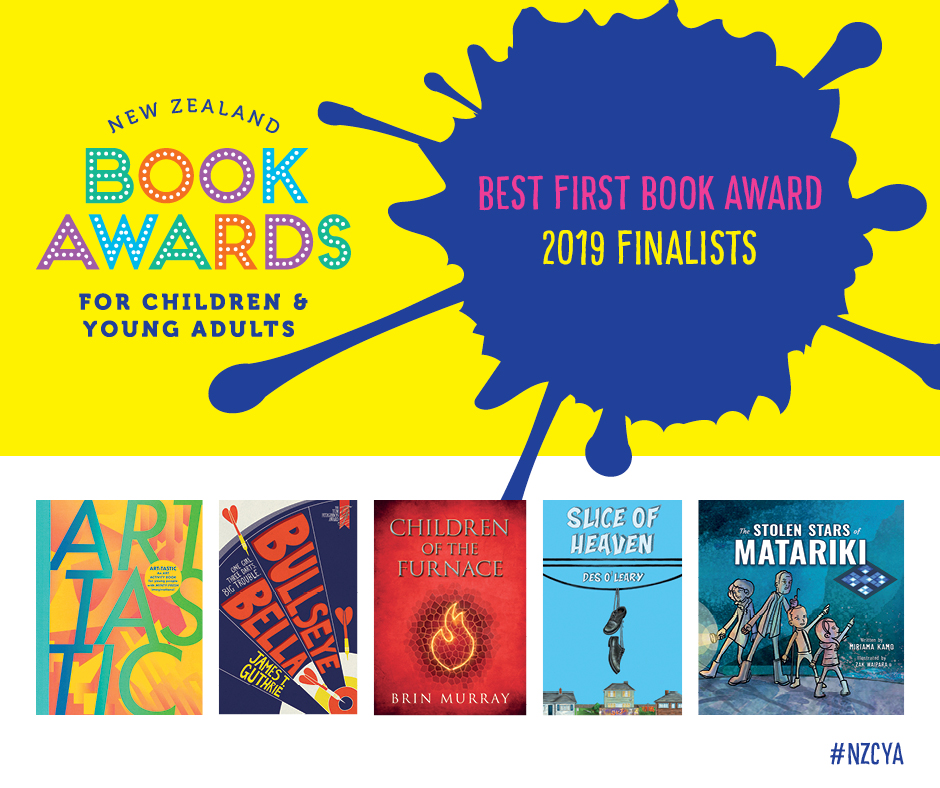
Art-tastic, Sarah Pepperle (Christchurch Art Gallery Te Puna o Waiwhetū)
Refer to the enthusiasm in the Non-fiction section!
Bullseye Bella, James T Guthrie (Scholastic NZ)
Bella is a super talented darts player – and as a 12-year-old girl, she raises a whole lot of eyebrows when she enters a pub competition. This was the super deserving winner of the Storylines Tom Fitzgibbon Award for an unpublished manuscript last year.
Children of the Furnace, Brin Murray (The CopyPress)
Refer to the mystical fantastical mention in the YA section!
Slice of Heaven, Des O’Leary (Mākaro Press)
South Auckland and surprise softball? It’s a winning combo in a part of Aotearoa that doesn’t get as much positive attention on the page as it deserves. Also a great addition to what’s available when there’s not much in the way of sporting stories being published.
The Stolen Stars of Matariki, Miriama Kamo, illustrated by Zak Waipara (Scholastic NZ)
The English language version of The Stolen Stars of Matariki is a lovely tale in the growing Matariki picture book space. Great to see it as a contender in two languages!
Sarah: Okay, I’ll admit, I’m a bit under-read on this list! But I’m going to go with a choice based on its inclusion on earlier lists: I think that Art-tastic will take out Best First Book as well. I think if it is good enough to win Non-fiction, it’s good enough to win BFB. So there.
Briar: I would love to see Bullseye Bella win, but since it has already won a national-level award, I’m going to register my semi-official backing of Slice of Heaven. As a former Papatoetoe kid (for a while, anyway), I love seeing tales of the wider South Auckland area being told.
Wright Family Foundation Te Kura Pounamu Award for books written completely in te reo MĀori
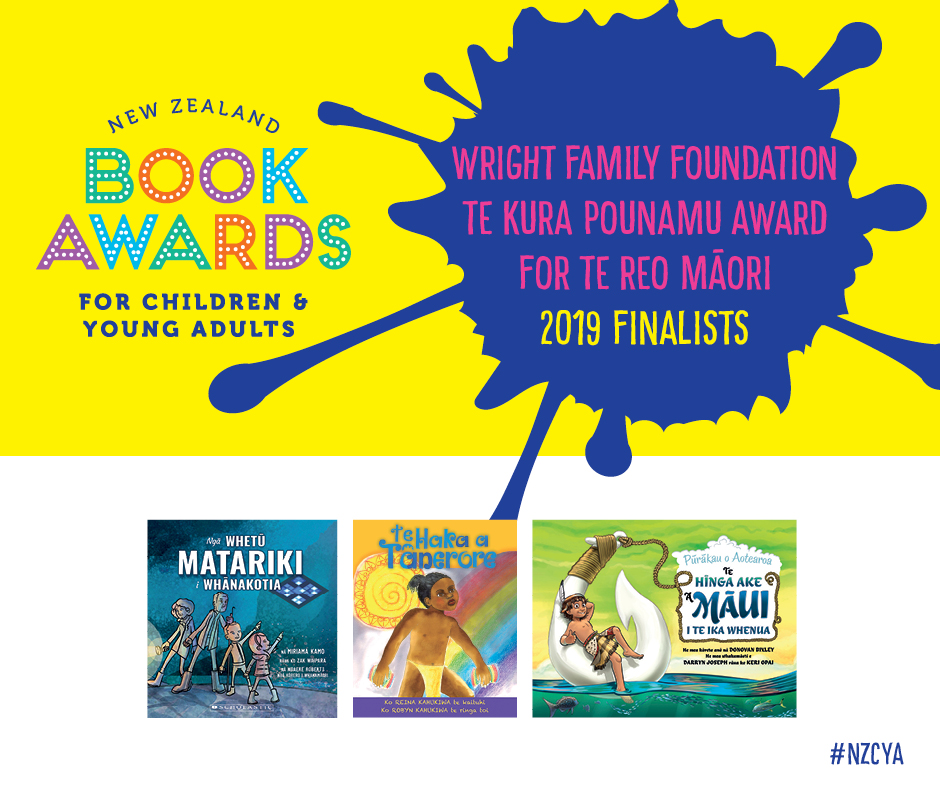
Ngā Whetū Matariki i Whānakotia, by Miriama Kamo and Zak Waipara, translated by Ngaere Roberts (Scholastic NZ)
This te reo translation of Miriama Kamo’s first book is a great addition to the growing options of books about Matariki, ably translated by Ngaere Roberts (whose work allows so many of Scholastic NZ’s books to be available in te reo Māori these days!)
Te Haka a Tānerore, by Reina Kahukiwa and Robyn Kahukiwa, translated by Kiwa Hammond (Mauri Tū)
The story of the first haka, written by Reina Kahukiwa, translated by Kiwa Hammond and illustrated by Robyn Kahukiwa in that incredible style that is familiar to us all. Vitally important to see more of these stories told in te reo and illustrated by tangata whenua.
Te Hīnga Ake a Māui i Te Ika Whenua, by Donovan Bixley, translated by Darryn Joseph (cultural adviser) and Keri Opai (Upstart Press)
A welcome addition to the versions of Maui tales available to young readers. Māori versions of Peter Gossage’s classics aren’t currently in print, so this option, with its hyper-modern Disney-esque illustrations, is much needed.
Briar: I’ll leave the real hot takes to those who can more fluently read these than me and my meagre reo can manage. But one whakaaro I think is worth highlighting that all three aren’t just in te reo Māori, but they are Māori stories – whether focusing on Matariki, on a tale of Maui familiar to all of us, or the story of Tānerore, which may not be familiar to all but is a core part of Māori tradition. Ka rawe.



